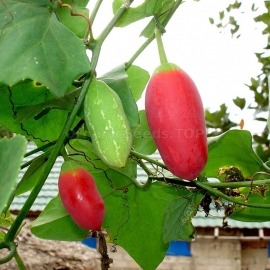 SALE
EXCLUSIVE
SALE
EXCLUSIVE


Organic Aztec sweet Herb Seeds / Lippia dulcis
1.50 €
3.00 € (Discount: 50%)
A perennial creeping plant, with beautiful and very fragrant oval leaves and small white flowers, collected in a small cone-shaped cob, contains the sweetener hernandulcin, which is 1000 times sweeter than sugar.
-
Aztec sweet herb, bushy lippia, honeyherb, hierba dulce / Lippia dulcis
This is a perennial creeping plant from the verbena family, with beautiful and very fragrant oval leaves and small white flowers collected in a small cone-shaped cob. In open ground, it grows a lush bush falling apart in different directions. The length of the stems can reach a meter mark.
Lippia prefers rich, well-drained soil and regular watering, loves warmth and sunshine. The plant is easily damaged by frost - even with a short-term drop in temperature by one or two degrees below zero, its stems die off, therefore, in more temperate latitudes, it is grown as an annual. However, lippia lives well at home - in a container, pot and hanging basket, she will feel great even in the conditions of the Russian winter.
For planting lipppia seeds, use very loose soil or coconut tablets or coconut mats, lightly sprinkling the seeds with a small layer of substrate. Sowing must be covered with glass or film and germinated in a warm place so that the temperature is maintained at about 30 degrees.
Even under optimal conditions, lipppia seeds germinate for a long time - about a month. Seedlings grow slowly at first, and only after the appearance of 3-4 true leaves, their growth accelerates.
With a lack of lighting and low humidity, lippies suffer and can lose almost all the leaves, but when favorable conditions occur, they quickly come to life.
Lippia seedlings are planted in the ground in late May - early June, when stable heat is established. While the nights are cold, the plants grow very slowly. Strong growth in lippias began only in July, when it became steadily above 15 degrees at night. At the same time, lippia already needs to be fed with fertilizers. Grass shoots grow up to a meter, they take root very easily when in contact with wet ground, and therefore it is advisable for them to put props. If this is not done, then lippia quickly occupies a significant area.
Under favorable conditions, the sweet grass of the Aztecs blooms profusely and for a long time. Lippia flowers are very small (less than a millimeter), collected in large inflorescences in the axils of the leaves. The plant is self-fertile and produces seeds without cross-pollination, but only under favorable conditions. With a lack of light and heat, the seeds of lippia do not form.
For subsequent propagation, you can collect the seeds of lipppia, which ripen gradually, and they are collected selectively. At the very beginning of the ripening of the seedlings, they become loose and begin to crumble. In this state, they must be collected, since overexposure to the plant leads to the loss of a significant amount of seeds. Lippia seeds are dried on paper, the seeds are collected and stored for storage.
Lippia cuttings take root very easily, both in water and in soil. For rooting, you need to take a well-ripened cutting with 5-6 pairs of leaves and put it in water, or plant it at home in a seedling cup. At first, to reduce evaporation, it is advisable to cover the cutting with a plastic bag. At room temperature, the rooting of a lippia cutting usually takes place within two weeks. It can be planted in open ground only when high temperatures are established. In areas with cold summers, it is preferable to grow lipppia in greenhouses.
In the heat, in the bright southern sun, the plants are oppressed, the leaves of lippia acquire a bronze tint, it is advisable to prevent this, therefore lippia develops best in partial shade under trees with a sparse crown (for example, in the shade of peach trees).
Lippia shoots are cut off for raw materials, which have not yet begun to lignify, after which they are dried in the shade, like any grass. Subsequently, the dried sweet Aztec herb can be added to tea or homemade preparations.
With this product buy
Product code: 8605
1.14 €
Herbaceous perennial with thick, reddish stems, large, drooping leaves and plump purple berries. Native to the US, especially the southern states. A handsome weed much appreciated by birds, as the berries occur in large pendant clusters, very fruity.
Product code: 10483
1.14 €
Called "Queen of the Herbs" in Ireland, where its tendency to grow under elder trees imbued it with elder’s magical reputation. In England it became a common treatment for "king’s evil," or scrofula (tuberculosis of the lymphatic glands).
Product code: 12399
4.97 €
The Feijoa or Pineapple Guava is a container plant with green, egg-shaped fruits that taste sweet-sour and smell like pineapples. They can be eaten fresh or, for example, be mixed in salads or pies.
Product code: 13590
4.97 €
This is a perennial plant of the pumpkin family, which is why it is also called ivy pumpkin, but the fruits are more like cucumbers, grows very quickly, begins to bloom and bear fruit in the second year.




